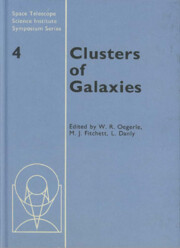Book contents
- Frontmatter
- Contents
- Preface
- Participants
- Chapter 1 Cosmology and Cluster Formation
- Chapter 2 Clusters of Galaxies: Structure, Infall, and Large-Scale Distribution
- Chapter 3 Cosmogony with Clusters of Galaxies
- Chapter 4 Cosmogony and the Structure of Rich Clusters of Galaxies
- Chapter 5 The Dark Matter Distribution in Clusters
- Chapter 6 The Effect of the Cluster Environment on Galaxies
- Chapter 7 Evidence for Gas Deficiency in Cluster Galaxies
- Chapter 8 Properties of Galaxies in Groups and Clusters
- Chapter 9 Dynamical Evolution of Clusters of Galaxies
- Chapter 10 Hot Gas in Clusters of Galaxies
- Chapter 11 Hydrodynamic Simulations of the Intracluster Medium
- Chapter 12 Evolution of Clusters in the Hierarchical Scenario
- Chapter 13 Distant Clusters as Cosmological Laboratories
- Chapter 14 Future Key Optical Observations of Galaxy Clusters
- Chapter 15 Cluster Research with X-ray Observations
- Plate section
Chapter 8 - Properties of Galaxies in Groups and Clusters
Published online by Cambridge University Press: 06 July 2010
- Frontmatter
- Contents
- Preface
- Participants
- Chapter 1 Cosmology and Cluster Formation
- Chapter 2 Clusters of Galaxies: Structure, Infall, and Large-Scale Distribution
- Chapter 3 Cosmogony with Clusters of Galaxies
- Chapter 4 Cosmogony and the Structure of Rich Clusters of Galaxies
- Chapter 5 The Dark Matter Distribution in Clusters
- Chapter 6 The Effect of the Cluster Environment on Galaxies
- Chapter 7 Evidence for Gas Deficiency in Cluster Galaxies
- Chapter 8 Properties of Galaxies in Groups and Clusters
- Chapter 9 Dynamical Evolution of Clusters of Galaxies
- Chapter 10 Hot Gas in Clusters of Galaxies
- Chapter 11 Hydrodynamic Simulations of the Intracluster Medium
- Chapter 12 Evolution of Clusters in the Hierarchical Scenario
- Chapter 13 Distant Clusters as Cosmological Laboratories
- Chapter 14 Future Key Optical Observations of Galaxy Clusters
- Chapter 15 Cluster Research with X-ray Observations
- Plate section
Summary
Abstract. Data on kinematics, spatial distributions, and galaxy morphology in different density regimes within individual galaxy clusters show that many clusters are not in a stationary state but are still in the process of forming.
INTRODUCTION
Paradigms for galaxy clusters are changing. As in all tearing away from secure positions (Kuhn 1970) the process is controversial, yet continuing. Most papers in this volume suggest directions that will probably lead to even stronger new ideas about cluster cosmogony. We are concerned in this review with physical properties that have relevance for the question of whether clusters of galaxies are generally stationary, changing only slowly in a crossing time or if they are dynamically young. We examine if parts of a cluster may still be forming, falling onto an old dense core that would have been the first part of a density fluctuation to collapse even if all galaxies in a cluster are the same age, having formed before the cluster. During the 1930's the stationary nature of clusters seemed beyond doubt. A suggestion that they are dynamically young would have been too radical even for Zwicky who was the model of prophetic radicals. Rather, Zwicky (1937) took the stationary state to be given in making his calculation of a total mass, following an earlier calculation by Sinclair Smith (1936). The justification was that rich clusters such as Coma (1257 +2812; or Abell A1656), Cor Bor (1520 +2754; A2065), Bootis (1431 +3146; A1930), and Ursa Major No.2 (1055 +5702; A1132), known already to Hubble (1936) and to Humason (1936), appear so regular.
- Type
- Chapter
- Information
- Clusters of Galaxies , pp. 201 - 230Publisher: Cambridge University PressPrint publication year: 1990
- 3
- Cited by



